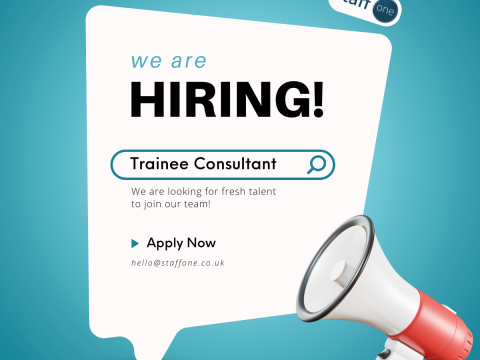- Contact us:
- 03300 535 600
- hello@staffone.co.uk
Why Your Job Description Should Focus On Activities
This week we have collaborated with our long-time partners Vervoe, the recruitment technology business who’s mission is to fundamentally transform the hiring process from mediocracy to meritocracy.
Alongside their founder, we’ve put our heads together to define how better to advertise your role. Here’s how to write a job description that will attract the right candidates.
“Focus on the journey, not the destination. Joy is found not in finishing an activity but in doing it.”
– Greg Anderson
Why Focus on Activities?
People are hired to perform value-adding activities. While companies have different approaches to how they hire, their goals are usually the same. Every company wants to hire high-performing people, not people who just look good on paper.
Despite this simple and obvious assumption, too many companies ignore activities and focus on things that don’t indicate performance. This happens at every stage of the hiring process. For example:
- Many job descriptions focus on what candidates have done in the past.
- Screening is based on candidates’ backgrounds.
- Assessment methods often don’t simulate the tasks are performed in the role.
Instead, use on-the-job activities as the guide for the entire hiring process. If you follow this principle, you will hire people who perform the value-adding activities you require.
Here’s how it works.
The Job Description
“If you don’t know where you are going, any road will get you there.”
– Lewis Carroll
Defining the role is the foundation of hiring. If you do that incorrectly, the entire hiring process will be steered in the wrong direction. The clearer you are, the higher your chances of attracting the person you want.
The problem with so many job descriptions is that they are aren’t linked closely enough to the daily activities of the job. Let’s change that.
A good job description should have three sections:
1. Start with why
“People don’t buy what you do, they buy why you do it.”
– Simon Sinek
This approach is entirely applicable to job descriptions. Sell candidates on your company’s vision and story. Sell them on the role and the culture. This will achieve two things. First, it is likely to increase the quality of applicants. Second, candidates will be more likely to invest in the application process and make an effort if they buy into your “why”.
Conversely, candidates who don’t relate to your vision or culture will opt out. Mission accomplished.
2. Describe the role in activities
Outline, point by point, what the successful candidate will do every day. Keep it simple and be very specific. No clichés, no jargon. Candidates need to understand how they will spend each day, what they need to achieve, who they’ll be working with and under what conditions.
This is a great way of managing expectations. By communicating to candidates what they’ll be doing in the role, you are forcing them to ask themselves whether they can do those activities well and how much they enjoy doing them. This presents another opportunity for less suitable candidates to opt out.
3. State your requirements
The previous two sections should make this part easy because you’ve set the scene. Candidates already know what your company stands for and what they’ll be doing in the role. Now you can add some more detail about the type of person you are looking for and how you expect them to approach the role.
Don’t worry about years of experience, grades in college or anything else that’s not activity-based. Bring it back to activities and use plain English.
Describe the kind of person you’re looking for by listing how you want them to approach the role. Put thing in context. Instead of “strong communicator”, write “clearly communicate customer feedback to the product team”. Instead of “flexible”, write “prepared to join calls with developers late at night when necessary”.
You should also use this section to articulate the attitude and behaviors you’d like to see. Candidates already know from the previous section what they’ll be doing on a daily basis. Now explain how.
Here are some examples of good job descriptions and a useful guide on how to write one.
Candidate Screening
“The doors of wisdom are never shut.”
– Benjamin Franklin
With a good job description and scenario-based assessment, candidate screening is simply not required. To learn more about why you don’t need to screen candidates read this.
But in short, screening is not about activities, it’s about a candidate’s background. Ruling people out based on their background is counterproductive. Instead, set candidates up for success with a savvy job description, and then assess the ones that want the job based on that description.
Don’t worry about receiving too many applications from people who aren’t qualified or ignore the job description. That is solved automatically in the assessment stage and you won’t need to lift a finger.
Scenario-based Assessment
“An ounce of performance is worth pounds of promises.”
– Mae West
Your job description will attract people who want to be part of your journey, and want to do the job you advertised. That’s the theory at least.
Now it’s time to find out how it stacks up.
The assessment stage, which is the most important part of your hiring process, should be entirely based on activities. Go back to the job description and choose the most important on-the-job activities.
Create simulations of those activities so you can see how candidates perform in real-world scenarios. To learn how to write a great interview script read this.
Use automated interviews to deliver the simulations to candidates online.
Some candidates will not make the effort. Others will find the activities too challenging. Others yet will see that the activities are not aligned with their interests or passions. The most motivated and qualified candidates will prevail.
It’s easy to read a job description and apply for a job. However, when candidates are asked to perform challenging tasks, they need to be motivated and confident in their abilities. You’ll only need to view and score completed interviews and you’ll know who measures up within minutes.
Using automated interviews based on activities, you can audition candidates for the role. They will, in turn, get a chance to do the role, albeit in a small way.
The candidates who perform well in the automated interviews will have proven they can do the activities you want them to do in the role. Seeing first hand how well they perform each of those activities will help you confidently make your hiring decision.
By focusing on activities, you can create a hiring process that reflects your role and how you want it to be performed. It’s a simple and effective method to hire people who can, and want to, perform the activities you consider to be value-adding.
AUTHOR
Omer Molad
Making hiring about merit, not background | Co-founder and CEO of Vervoe






